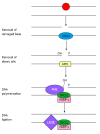Polymorphisms in base excision repair genes: Breast cancer risk and individual radiosensitivity
- PMID: 25493225
- PMCID: PMC4259949
- DOI: 10.5306/wjco.v5.i5.874
Polymorphisms in base excision repair genes: Breast cancer risk and individual radiosensitivity
Abstract
Breast cancer (BC) is the most common cancer among women worldwide. The aetiology and carcinogenesis of BC are not clearly defined, although genetic, hormonal, lifestyle and environmental risk factors have been established. The most common treatment for BC includes breast-conserving surgery followed by a standard radiotherapy (RT) regimen. However, radiation hypersensitivity and the occurrence of RT-induced toxicity in normal tissue may affect patients' treatment. The role of DNA repair in cancer has been extensively investigated, and an impaired DNA damage response may increase the risk of BC and individual radiosensitivity. Single nucleotide polymorphisms (SNPs) in DNA repair genes may alter protein function and modulate DNA repair efficiency, influencing the development of various cancers, including BC. SNPs in DNA repair genes have also been studied as potential predictive factors for the risk of RT-induced side effects. Here, we review the literature on the association between SNPs in base excision repair (BER) genes and BC risk. We focused on X-ray repair cross complementing group 1 (XRCC1), which plays a key role in BER, and on 8-oxoguanine DNA glycosylase 1, apurinic/apyrimidinic endonuclease 1 and poly (ADP-ribose) polymerase-1, which encode three important BER enzymes that interact with XRCC1. Although no association between SNPs and radiation toxicity has been validated thus far, we also report published studies on XRCC1 SNPs and variants in other BER genes and RT-induced side effects in BC patients, emphasising that large well-designed studies are needed to determine the genetic components of individual radiosensitivity.
Keywords: Base excision repair; Breast cancer; Polymorphisms; Radiosensitivity; Susceptibility.
Figures


Similar articles
-
Impact of genetic polymorphisms in base excision repair genes on the risk of breast cancer in a Korean population.Gene. 2013 Dec 15;532(2):192-6. doi: 10.1016/j.gene.2013.09.069. Epub 2013 Sep 25. Gene. 2013. PMID: 24076439
-
Single nucleotide polymorphisms of DNA base-excision repair genes (APE1, OGG1 and XRCC1) associated with breast cancer risk in a Chinese population.Asian Pac J Cancer Prev. 2014;15(3):1133-40. doi: 10.7314/apjcp.2014.15.3.1133. Asian Pac J Cancer Prev. 2014. PMID: 24606430
-
Association of genetic polymorphisms in the base excision repair pathway with lung cancer risk: a meta-analysis.Lung Cancer. 2006 Dec;54(3):267-83. doi: 10.1016/j.lungcan.2006.08.009. Epub 2006 Sep 18. Lung Cancer. 2006. PMID: 16982113 Review.
-
DNA repair genes polymorphisms and genetic susceptibility to Philadelphia-negative myeloproliferative neoplasms in a Portuguese population: The role of base excision repair genes polymorphisms.Oncol Lett. 2017 Jun;13(6):4641-4650. doi: 10.3892/ol.2017.6065. Epub 2017 Apr 21. Oncol Lett. 2017. PMID: 28599464 Free PMC article.
-
Polymorphisms of DNA repair genes: ADPRT, XRCC1, and XPD and cancer risk in genetic epidemiology.Methods Mol Biol. 2009;471:305-33. doi: 10.1007/978-1-59745-416-2_16. Methods Mol Biol. 2009. PMID: 19109787 Review.
Cited by
-
Low-intensity red and infrared lasers affect mRNA expression of DNA nucleotide excision repair in skin and muscle tissue.Lasers Med Sci. 2016 Apr;31(3):429-35. doi: 10.1007/s10103-016-1870-6. Epub 2016 Jan 21. Lasers Med Sci. 2016. PMID: 26796702
-
Identification of a New Prediction Model for Bladder Cancer Related to Immune Functions and Chemotherapy Using Gene Sets of Biological Processes.Biomed Res Int. 2022 Oct 30;2022:4740686. doi: 10.1155/2022/4740686. eCollection 2022. Biomed Res Int. 2022. PMID: 36349315 Free PMC article.
-
Nrf2 promotes survival following exposure to ionizing radiation.Free Radic Biol Med. 2015 Nov;88(Pt B):268-274. doi: 10.1016/j.freeradbiomed.2015.04.035. Epub 2015 May 12. Free Radic Biol Med. 2015. PMID: 25975985 Free PMC article. Review.
-
NBN, RAD51 and XRCC3 Polymorphisms as Potential Predictive Biomarkers of Adjuvant Radiotherapy Toxicity in Early HER2-Positive Breast Cancer.Cancers (Basel). 2022 Sep 8;14(18):4365. doi: 10.3390/cancers14184365. Cancers (Basel). 2022. PMID: 36139526 Free PMC article.
-
The overexpression of DNA repair genes in invasive ductal and lobular breast carcinomas: Insights on individual variations and precision medicine.PLoS One. 2021 Mar 4;16(3):e0247837. doi: 10.1371/journal.pone.0247837. eCollection 2021. PLoS One. 2021. PMID: 33662042 Free PMC article.
References
-
- Bray F, Ren JS, Masuyer E, Ferlay J. Global estimates of cancer prevalence for 27 sites in the adult population in 2008. Int J Cancer. 2013;132:1133–1145. - PubMed
-
- Ghoussaini M, Pharoah PD, Easton DF. Inherited genetic susceptibility to breast cancer: the beginning of the end or the end of the beginning? Am J Pathol. 2013;183:1038–1051. - PubMed
-
- Goode EL, Ulrich CM, Potter JD. Polymorphisms in DNA repair genes and associations with cancer risk. Cancer Epidemiol Biomarkers Prev. 2002;11:1513–1530. - PubMed
Publication types
LinkOut - more resources
Full Text Sources
Other Literature Sources
Research Materials

